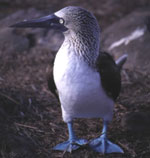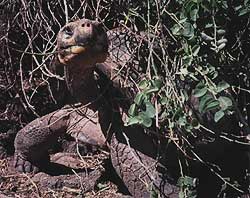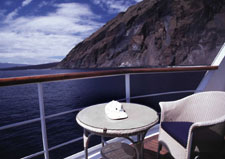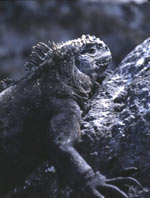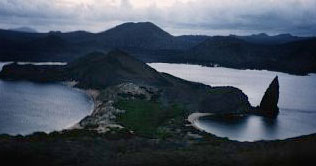"Where were you yesterday?" asked the ticket agent at the check in counter as he pointed to the previous day's date on my airplane ticket. "What?" I yelped, my heart plummeting to my toes. Then, just to make sure he understood, I yelped once more, "What?!"
For my trip to the Galapagos I'd booked three flights on American Airlines. From New York to Raleigh, there to Miami, then to Quito, the capital of Ecuador. I'd arrived early at JFK, too early I thought, until I heard those fateful words. So what do you do when you show up a day late for a flight on which your entire itinerary depends? You panic!
While my head swam the ticket agent was keeping his. In no time he'd rebooked all my flights and I was hurrying to call my travel agent. "Get on the plane," she told me, "and call me from Miami." Several hours later I picked up a telephone with trembling hands and waited for the sound of her voice. "I've arranged everything," she said. "Someone will meet you at the airport. You'll spend three nights at the Hilton and meet the boat on Thursday.
Well, yes and no. If penance for my stupidity required killing two days, it wasn't going to be in Quito. At a moment's notice, Sylvia Moncayo of Metropolitan Touring, the Ecuadorean tour operator that owned the ship, had me flying to the Galapagos.
I landed at an airport on a speck of volcanic ash called Baltra Island. With other pilgrims I ferried and bussed to Puerto Ayora, a whimsical village wrapped around a boat-studded bay. Soon I was safely ensconced in the Hotel Delfin overlooking a cactus garden and swimming pool while prehistoric-looking frigate birds wheeled overhead.
Just ahead in a magnificent domed cave a green sea turtle raised its head out of the water. "They're very shy," said Gilda, one of the five naturalist-guides on the Santa Cruz. "She'll dive as soon as she sees us." Apparently this sea turtle had bad eyesight.
Around the corner, past fat spiny iguanas and somnolent sea lions, we came upon four Galapagos penguins, cute little creatures cavorting in the bay. Riding the waves above a swath of bright green algae, they hopped onto the rocks almost close enough to touch.
At eleven o'clock we had the option of snorkeling until lunch or taking the glass bottom boat. A foot dipped briefly in the water made the decision painfully easy. Even easier for me was to curl into one of the wicker chaises on my private balcony and
match the mood of the Pacific Ocean.
Four new cabins had been added to the Santa Cruz
during its recent refurbishing. Mine, B-19, was one.
It curved around the starboard side of the stern with
sliding glass doors opening to the terrace. The colors
inside were deep green and brown with a queen size
bed, large writing desk, chairs and sofa and a full wardrobe. The bathroom was equally impressive, roomy and bright with a man size walk-in shower.
Later I sneaked a peek into the smaller cabins on the lower decks. Like mine they were spotless and handsomely appointed. Though much less spacious, they looked very comfortable. As was the airy dining room where consistantly excellent meals were served by friendly waiters who knew our preferences after a single day.
Following lunch on Friday we pangaed to Fernandina Island where a mass of black
marine iguanas with dragon heads and swollen bellies tumbled over each other on the path near the dock. Every bit as eerie were fields of ropey lava, swirls and twists of liquid that had frozen into porous black stone. Brilliant discs sparkled like orange mica
embedded in the dark outcroppings by the shore.
When they moved I realized they were crabs,
hundreds of them, crawling and hopping from
rock to rock and even climbing trees, but doing
their best to stay out of the water. "Sally Light-
foot crabs hate to swim," said Gilda.
We worked our way slowly around the cove,
stopping to look at flightless cormorants drying
their stunted wings, at American oyster catchers
with bright red bills and, best of all, at a weeks-old
baby sea lion playing under its mother's watchful eye while daddy barked away any other male who came near.
It's futile to talk of highlights when you speak of the Galapagos. Every day brought new expressions of wonder and delight. On Isabela Island we took walks over a coral sea bed that had been submerged for hundreds of years until volcanic activity in 1954 thrust
it into the air. We strolled across vast crusts of lava where lonely cactuses sprouting from crevasses and cracks grew taller than our heads. After an hour of unrelieved blackness we came upon a pool of water, green with the reflections of shining reeds. Floating in the center like a magic apparition was a single pink flamingo.
Meanwhile, those who had chosen to ride a panga alongside the coastline were seeing a jumble of birds and lizards and turtles while tossing on choppy seas. "It was brilliant," enthused Alan Barber from England. "Absolutely marvellous!"
"What's the big deal about Hood Island?" asked Claus, the head naturalist, at his evening briefing. "It's the oldest of the Galapagos Islands," he said, answering his own question. "It rose up in the last five million years. It's such a great island we'll spend the whole day there. Wakeup call is at 7:15."
Waking to the strains of gentle music, we ate and began the day with an overview of the underlife from the ship's glass bottom boat. Then we were deposited on a gorgeous white sand beach curving around a robin's egg bay. Sailing in we could see dark grey lumps spotted among the people already on shore. Lumps that moved, that rolled on their backs at the water's edge, flippers in the air, and let the waves break over them, that poked whiskered noses into outstretched hands. Really cute lumps.
At 10:30 we motored to nearby Turtle Islet and snorkeled. Someone saw a shark, someone else a stingray. I only saw multitudes of fish with coats of many colors: wrasses and sargeant majors, angelfish and butterflyfish, parrotfish and puffers. They were enough for me.
After a special Ecuadorean buffet we took one of the wonderful mini-siestas that preceded each day's activities. Then the Santa Cruz rounded the corner of Hood Island to Punta Suarez. Sea lions rolled over each other and leapt from the water like porpoises as the pangas ferried us to land. Blocking our way on the tiny dock was a unique
Hood Island iguana, its body streaked with red and green. On the beach a baby sea lion was tormenting another iguana with a mock attack at its tail. Impudent mocking birds hopped around our feet begging in vain for a handout. All this in the first five minutes.
Walking to the far side of the island we plopped down in the midst of a colony of masked boobies. Literally at our feet two attentive parents fed a pair of soft balls of fluff with chattering beaks. Finally we threaded our way along a rocky trail through the
entire kingdom - iguanas, boobies and sea lions. Hood Island was truly an abundance of riches.
That evening, still excited about what I'd seen, I overheard someone refer to the Galapagos as a "one time destination." Was this true? Not according to Sylvia Moncayo. "We always have clients coming back", she said. "And word of mouth is our best advertising." I was relieved to hear it. After all this was the second time for me. The
trip wasn't even over and I was already looking forward to another.
And next time I won't miss the boat.
SIDEBAR
FOR MORE INFORMATION about 3, 4 and 8 day cruises aboard the 90 passenger Santa Cruz, the 40 passenger Isabela II and the Hotel Delfin-cruise ship combination, call Metropolitan Touring's U.S. representative, Adventure Associates, at 800 527-2500. Visit their web site at www.ecuadorable.com.
HOW TO GET THERE: American Airlines, 800 433-7300, flies non-stop from Miami to Quito and Guyaquil. Tame Airlines flies on to the Galapagos. Flights can be arranged by a travel agent or Adventure Associates.
CLIMATE: The Galapagos Islands are located on the equator, so protection is always needed from the sun. The sometimes very hot rainy season is from December to June. Humididty is high, showers occasional, days generally sunny. From June to December expect cooler days. Generally, weather is similar to that in the Caribbean.
WHAT TO WEAR AND BRING: Clothing is informal. Bring sneakers or boat shoes, hiking shoes or hiking sandals, shorts and light weight long pants, long and short sleeved shirts and t-shirts, bathing suits, cap or wide-brimmed hat, light jacket or windbreaker, sunglasses, sun screen, camera, batteries and twice as much film as you think you'll
need. I brought convertible pants by Ex Officio, 800 644-7303. When the weather warmed up the legs zipped off. Highly recommended.
RECOMMENDED READING: "Ecuador Handbook," Moon Travel Handbooks. "Galagapos, a Natural History Guide," by Michael H. Jackson. "A traveler's Guide to the Galapagos Islands," by Barry Boyce. "The Voyage of the Beagle," by Charles Darwin.
